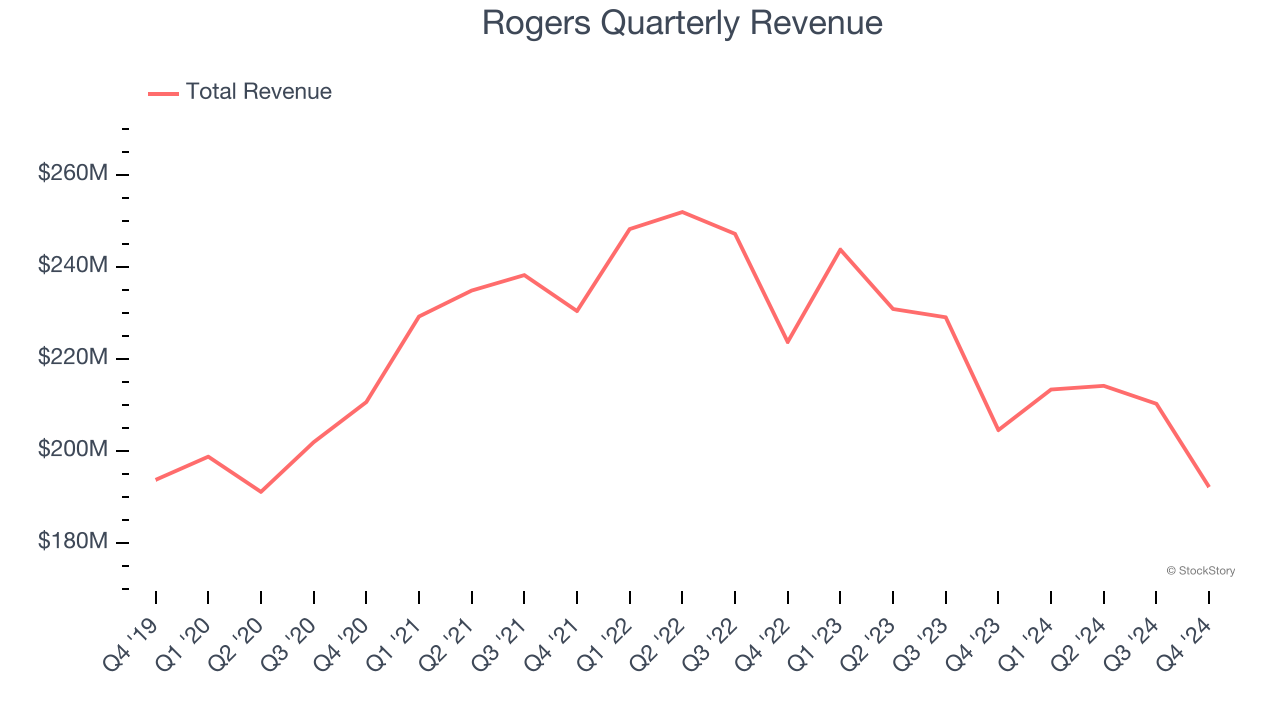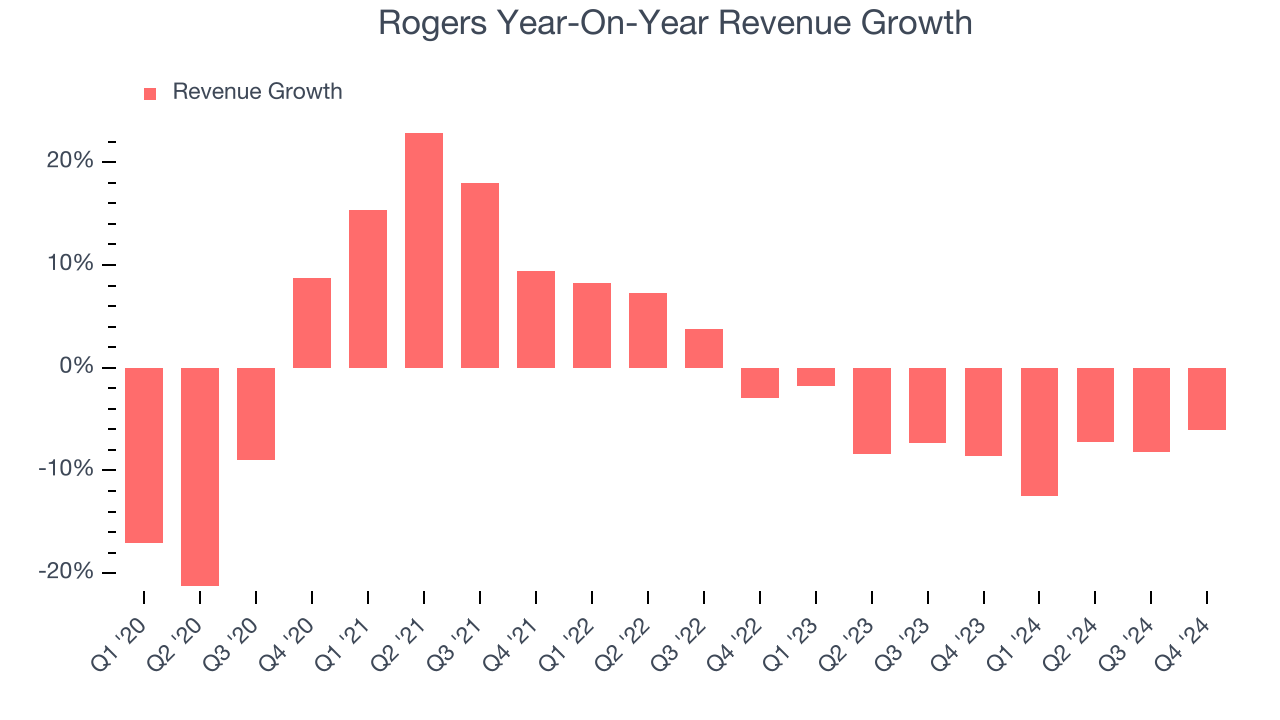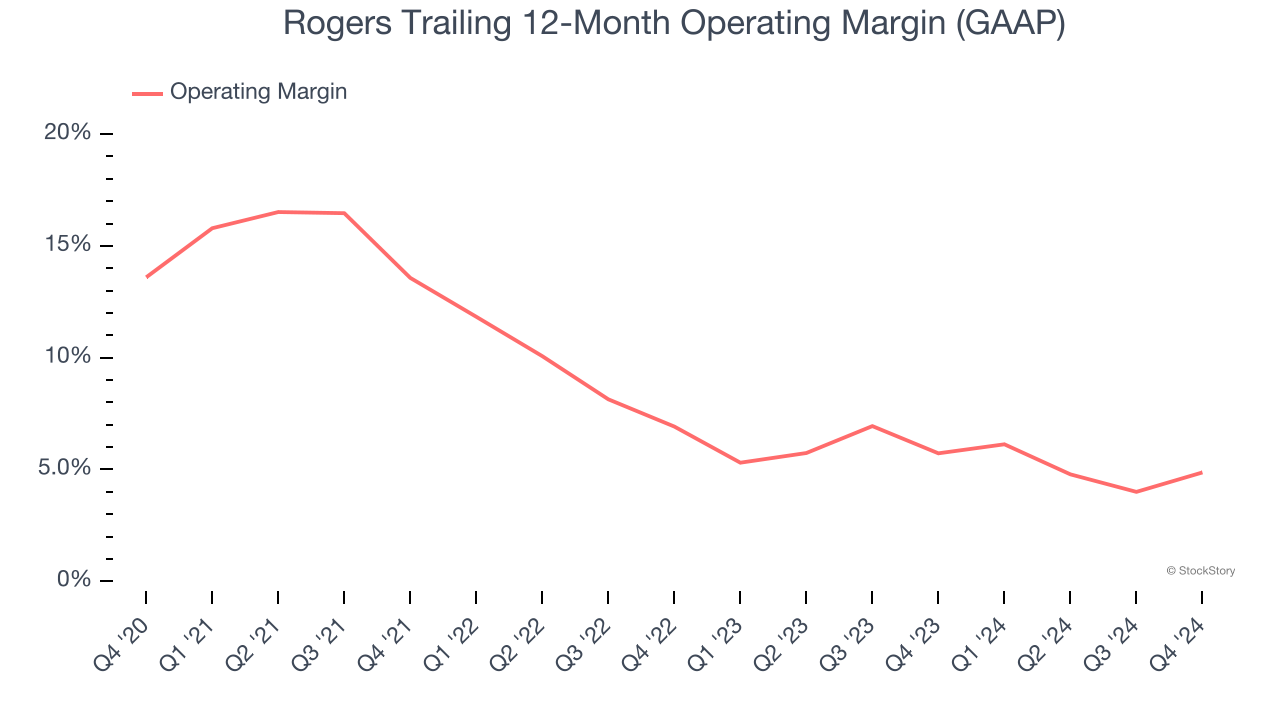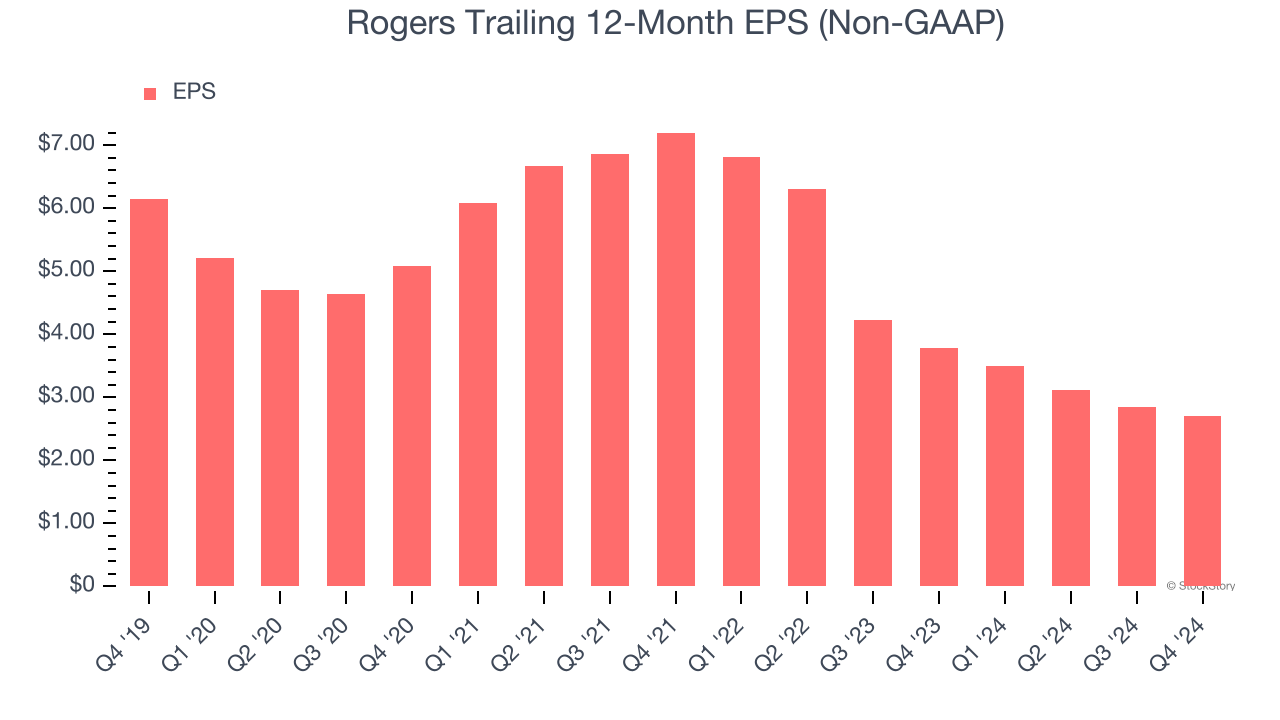
Advanced materials manufacturer Rogers (NYSE:ROG) met Wall Street’s revenue expectations in Q4 CY2024, but sales fell by 6.1% year on year to $192.2 million. On the other hand, next quarter’s revenue guidance of $187.5 million was less impressive, coming in 6.3% below analysts’ estimates. Its non-GAAP profit of $0.46 per share was 5.7% above analysts’ consensus estimates.
Is now the time to buy Rogers? Find out by accessing our full research report, it’s free.
Rogers (ROG) Q4 CY2024 Highlights:
- Revenue: $192.2 million vs analyst estimates of $191.8 million (6.1% year-on-year decline, in line)
- Adjusted EPS: $0.46 vs analyst estimates of $0.44 (5.7% beat)
- Adjusted EBITDA: $23.3 million vs analyst estimates of $21.7 million (12.1% margin, 7.4% beat)
- Revenue Guidance for Q1 CY2025 is $187.5 million at the midpoint, below analyst estimates of $200.2 million
- Adjusted EPS guidance for Q1 CY2025 is $0.25 at the midpoint, below analyst estimates of $0.72
- Operating Margin: -2.6%, up from -5.7% in the same quarter last year
- Free Cash Flow Margin: 9.5%, down from 24.2% in the same quarter last year
- Market Capitalization: $1.63 billion
"Our results were consistent with our guidance expectations for the fourth quarter,” stated Colin Gouveia, Rogers' President and CEO.
Company Overview
With its silicone foam used in Apollo 11’s mission to the moon, Rogers (NYSE:ROG) produces advanced materials for the telecommunications, automotive, and electronics industries.
Electronic Components
Like many equipment and component manufacturers, electronic components companies are buoyed by secular trends such as connectivity and industrial automation. More specific pockets of strong demand include data centers and telecommunications, which can benefit companies whose optical and transceiver offerings fit those markets. But like the broader industrials sector, these companies are also at the whim of economic cycles. Consumer spending, for example, can greatly impact these companies’ volumes.
Sales Growth
A company’s long-term performance is an indicator of its overall quality. While any business can experience short-term success, top-performing ones enjoy sustained growth for years. Over the last five years, Rogers’s demand was weak and its revenue declined by 1.6% per year. This was below our standards and is a sign of poor business quality.

We at StockStory place the most emphasis on long-term growth, but within industrials, a half-decade historical view may miss cycles, industry trends, or a company capitalizing on catalysts such as a new contract win or a successful product line. Rogers’s recent history shows its demand has stayed suppressed as its revenue has declined by 7.5% annually over the last two years. 
This quarter, Rogers reported a rather uninspiring 6.1% year-on-year revenue decline to $192.2 million of revenue, in line with Wall Street’s estimates. Company management is currently guiding for a 12.1% year-on-year decline in sales next quarter.
Looking further ahead, sell-side analysts expect revenue to grow 2.3% over the next 12 months. While this projection implies its newer products and services will fuel better top-line performance, it is still below average for the sector.
Here at StockStory, we certainly understand the potential of thematic investing. Diverse winners from Microsoft (MSFT) to Alphabet (GOOG), Coca-Cola (KO) to Monster Beverage (MNST) could all have been identified as promising growth stories with a megatrend driving the growth. So, in that spirit, we’ve identified a relatively under-the-radar profitable growth stock benefiting from the rise of AI, available to you FREE via this link.
Operating Margin
Rogers has done a decent job managing its cost base over the last five years. The company has produced an average operating margin of 8.9%, higher than the broader industrials sector.
Looking at the trend in its profitability, Rogers’s operating margin decreased by 8.7 percentage points over the last five years. Even though its historical margin is high, shareholders will want to see Rogers become more profitable in the future.

This quarter, Rogers generated an operating profit margin of negative 2.6%, up 3.1 percentage points year on year. The increase was encouraging, and since its operating margin rose more than its gross margin, we can infer it was recently more efficient with expenses such as marketing, R&D, and administrative overhead.
Earnings Per Share
We track the long-term change in earnings per share (EPS) for the same reason as long-term revenue growth. Compared to revenue, however, EPS highlights whether a company’s growth is profitable.
Sadly for Rogers, its EPS declined by more than its revenue over the last five years, dropping 15.1% annually. This tells us the company struggled because its fixed cost base made it difficult to adjust to shrinking demand.

We can take a deeper look into Rogers’s earnings to better understand the drivers of its performance. As we mentioned earlier, Rogers’s operating margin improved this quarter but declined by 8.7 percentage points over the last five years. This was the most relevant factor (aside from the revenue impact) behind its lower earnings; taxes and interest expenses can also affect EPS but don’t tell us as much about a company’s fundamentals.
Like with revenue, we analyze EPS over a more recent period because it can provide insight into an emerging theme or development for the business.
For Rogers, its one-year annual EPS declines of 28.3% show it’s continued to underperform. These results were bad no matter how you slice the data.
In Q4, Rogers reported EPS at $0.46, down from $0.60 in the same quarter last year. Despite falling year on year, this print beat analysts’ estimates by 5.7%. Over the next 12 months, Wall Street expects Rogers’s full-year EPS of $2.71 to grow 31.7%.
Key Takeaways from Rogers’s Q4 Results
We enjoyed seeing Rogers exceed analysts’ EPS expectations this quarter. On the other hand, its revenue guidance for next quarter missed significantly and its EPS guidance for next quarter fell short of Wall Street’s estimates. Zooming out, we think the guidance is weighing on shares, and the stock traded down 6.6% to $83.60 immediately after reporting.
Is Rogers an attractive investment opportunity at the current price? If you’re making that decision, you should consider the bigger picture of valuation, business qualities, as well as the latest earnings. We cover that in our actionable full research report which you can read here, it’s free.

